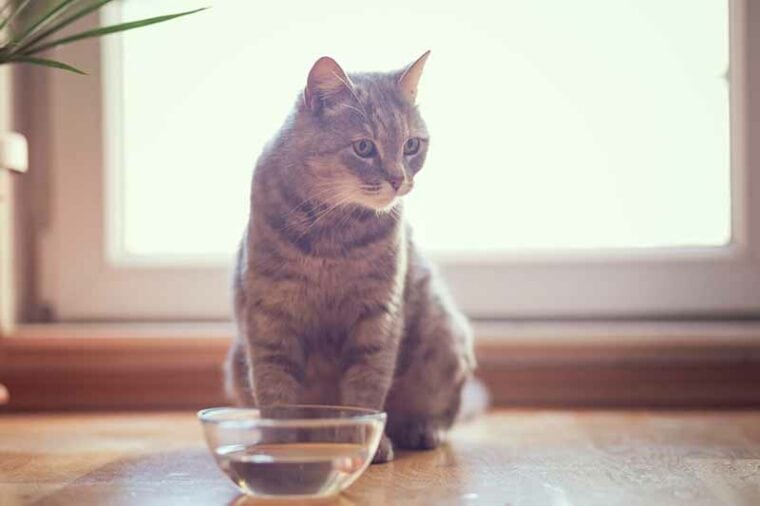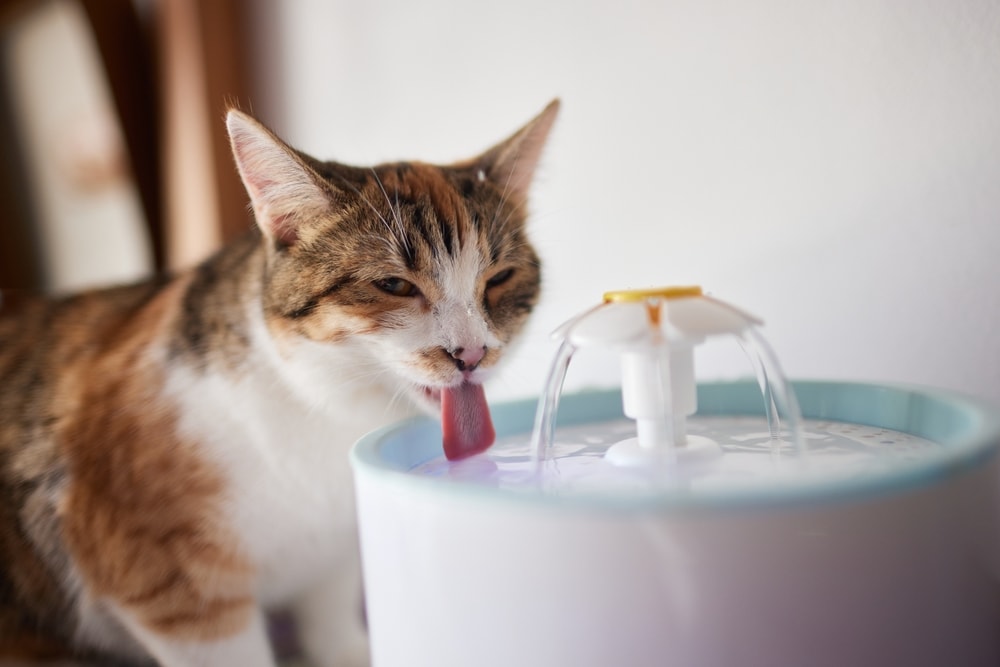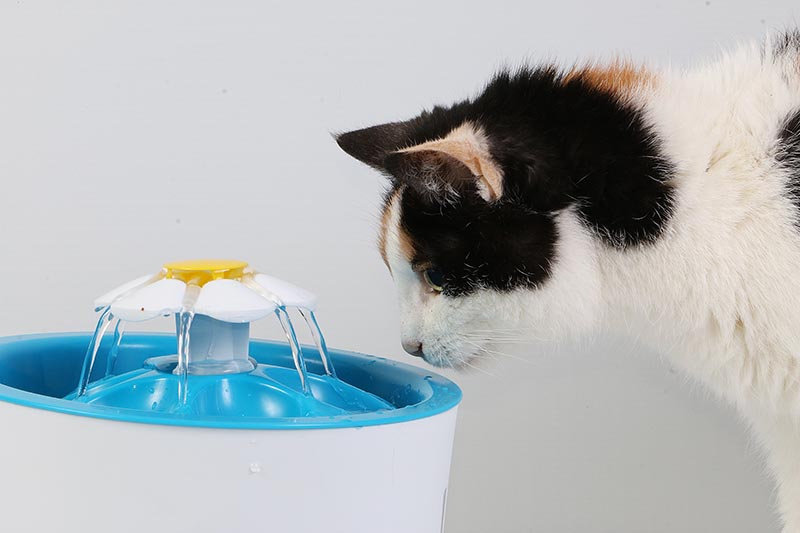
Cats are fascinating creatures that never cease to amaze their human companions. One of the most puzzling behaviors of cats is their aversion to water, and sometimes this can result in them not even drinking water – something that’s central to good health.
But while some felines enjoy drinking water from the sink or water fountains, others seem to avoid water at all costs. This behavior can be perplexing for cat owners, especially if their feline friend suffers from dehydration or urinary tract problems. But what causes this? Why would a cat avoid drinking water? Let’s discuss.
The 4 Likely Reasons Why Your Cat Is Not Drinking Water
1. Natural Aversion to Water in Cats
A bit of history… Cats are descendants of desert-dwelling wildcats that lived in dry environments and relied on their prey for hydration. Unlike dogs, who evolved from wolves and have a strong instinct for swimming and hunting in water, cats have no natural inclination to be in or around water.
Their ancestors didn’t have regular access to water sources, so they developed a low thirst drive and a preference for obtaining moisture from their food. Even domesticated cats that have access to fresh water might not drink as much as they need, leading to dehydration and health problems.
However, not all cats have a natural aversion to water. Some breeds, such as the Turkish Van, Bengal, and Maine Coon, have a strong affinity for water and enjoy playing in it. These cats have a genetic predisposition to water-related activities, which makes them more comfortable and confident around water. Even if your cat has a natural aversion to water, it’s important to make sure they stay hydrated.
2. Health Issues That May Cause Water Avoidance
Sometimes, a cat’s aversion to drinking water can be a sign of an underlying health issue. Cats that are suffering from an illness or pain might avoid water because it exacerbates their symptoms or makes them feel worse. For example, cats with dental problems might avoid drinking water because it hurts to swallow. Likewise, cats with digestive issues or mouth injuries might avoid drinking water due to the pain or discomfort it causes.
If you suspect that your cat’s aversion to water is caused by a health issue, be sure to take them to the vet for a check-up. The vet can perform a physical exam, blood tests, and urinalysis to determine if there’s an underlying problem that needs to be treated. Depending on the diagnosis, the vet might prescribe medication, dietary changes, or other treatments to help your cat feel better.

3. Environmental Issues That May Cause Water Avoidance
Your cat’s aversion to water might be caused by behavioral issues or changes in their environment. Cats are creatures of habit and routine, and any changes in their environment or routine can cause them to feel stressed or anxious. Some cats might avoid water if they associate it with a change in their environment, such as a move to a new house or the arrival of a new pet.
If the water bowl is placed near a very busy area, next to a noisy machine, or within a dog’s reach, a cat will avoid it. Additionally, cats that are used to being outdoors might be hesitant to drink water from a bowl because they’re used to drinking from puddles or streams.
To help your cat overcome this, try using a water fountain, which can mimic the sound and movement of running water and encourage your cat to drink more. Also, keep your cat’s water bowl in a calm and welcoming environment because noisy or stressful areas may cause them not to drink water in that area if they don’t feel comfortable.
4. Negative Experiences with Water
Another reason why your cat might be avoiding drinking water is negative experiences with it. Cats are creatures of habit and can develop an aversion to things that aren’t safe for them. If your cat had a traumatic experience with water, such as falling into a pool or getting sprayed with a hose, they might associate water with danger and try to avoid it at all costs–even if it means it goes thirsty for days on end.
Negative experiences with water can also be caused by well-intentioned but misguided owners. Some owners try to bathe their cats or force them to drink water, which can be stressful and uncomfortable for the cat. Additionally, water that isn’t clean and fresh may cause your cat not to drink it, so it’s important to keep your cat’s water and bowl clean and fresh.

Tips for Encouraging Your Cat to Drink More Water
Regardless of the reason why your cat is avoiding water, it is imperative to find ways to encourage them to drink more. Here are some tips to help your cat stay hydrated:
When shopping for a cat water fountain, it’s important to consider several factors to ensure the health and happiness of your cat. The good thing is that cat water fountains aren’t that expensive.
Finding a great water fountain that you and your cat will both love is harder than it sounds.
We recommend Hepper's Stainless Steel Cat Water Fountain, a beautifully designed option with triple filtration, adjustable flow modes, and a conveniently large capacity. This fountain is easy to clean (many parts are even dishwasher-safe!) and sturdy enough to last for years.
At Pet Keen, we've admired Hepper for many years, and decided to take a controlling ownership interest so that we could benefit from the outstanding designs of this cool company!
Filtration Type
Fountains have two types of filtration: mechanical (which prevents cat hair and other debris from getting into the pump) and chemical (which removes unpleasant odor and taste). The pumps are all pretty much the same and require the same cleaning, but the frequency of cleaning will depend on the type and quality of filtration.

Cost
Cost should also be taken into account. The initial cost of the fountain is not necessarily the real cost. If you have to frequently purchase parts or filtration units, the real cost will be the purchase price plus additional money spent over the months and years. Consider the longevity of the fountain, customer reviews, and the complexity of the parts. With the right information, you can choose the best fountain for your cats and your budget.
Safety
Safety is the first concern when it comes to cat water fountains. Ceramic, metal, and glass are non-porous and do not easily scratch, making them less likely to harbor bacteria. Plastic, on the other hand, is easily scratched and can lead to chin acne in cats. If the fountain is ceramic, make sure it’s made with food-safe glazes.
Cleaning Details
Cleaning should be easy and the fountain should remain clean for a reasonable amount of time. If the fountain has a lot of corners and crevices, it will be difficult to clean thoroughly and often enough to prevent bacteria build-up.
Cat Preference
It is also important to consider the cats’ attraction to the fountain. Most cats are naturally drawn to the water movement, but there are exceptions. Longhair cats may prefer a raised drinking area or a stream that keeps their fur dry.

Aesthetics
Aesthetics is another important factor. If the fountain is in a visible location, consider its look and how it will fit with the rest of the decor. It’s also important to consider the sounds the fountain makes as well.
Alternative Ways to Keep Your Cat Hydrated
In addition to drinking water, there are other ways to keep your cat hydrated. Here are some alternative ways to provide your cat with moisture:
Wrapping Things Up
Cats are often quite mysterious creatures, but understanding their behavior can help you become a better cat owner. If your cat is avoiding drinking water, it’s essential to find out why and take steps to encourage them to drink more.
Whether it’s a natural aversion, negative experiences, health issues, or behavioral issues, there are many ways to help your cat stay properly hydrated if it has this issue. And remember to be patient, understanding, and attentive to your cat’s needs, and you’ll have a happy and well-hydrated feline friend for years to come.
See also:
- My Cat Doesn’t Drink Water but Eats Wet Food: Vet-Approved Reasons & Tips
- What’s the Optimum Age to Bring a Parrotlet Home?
Featured Image Credit: Impact Photography, Shutterstock









